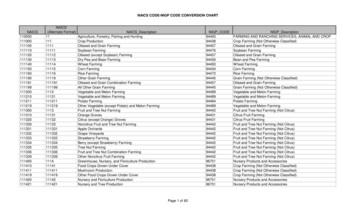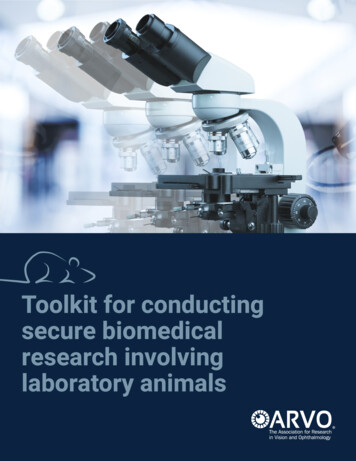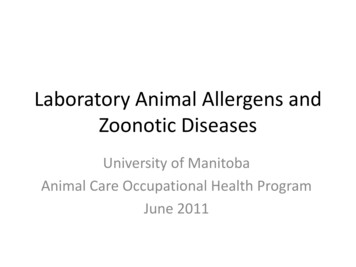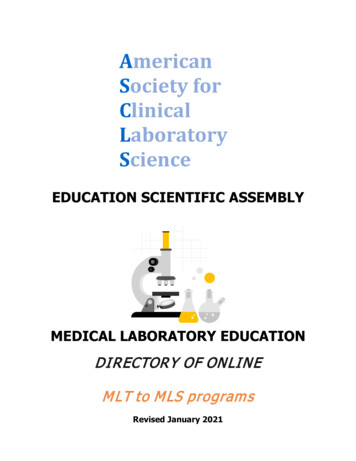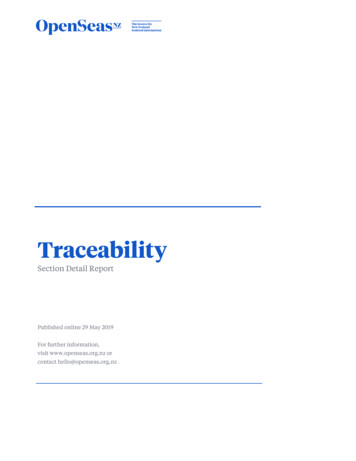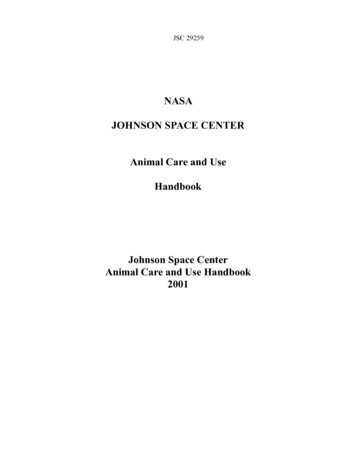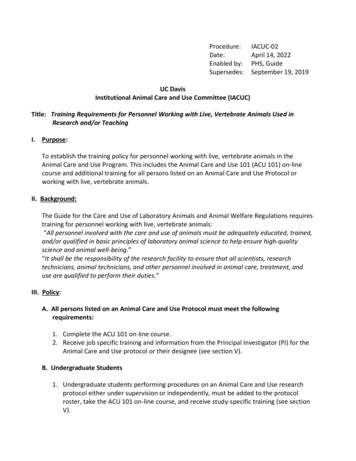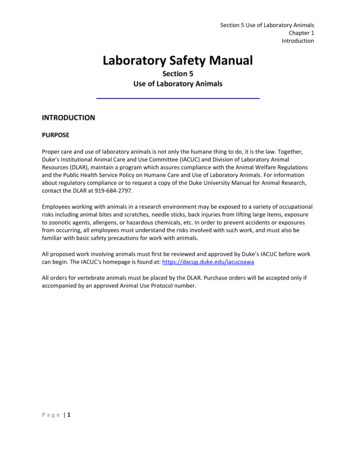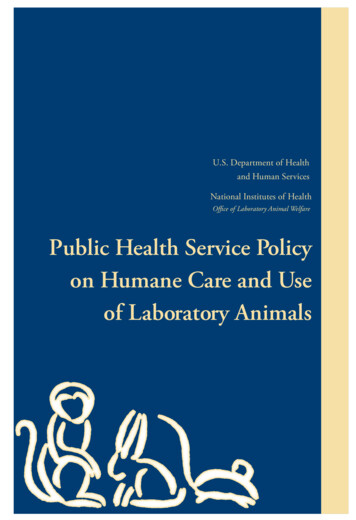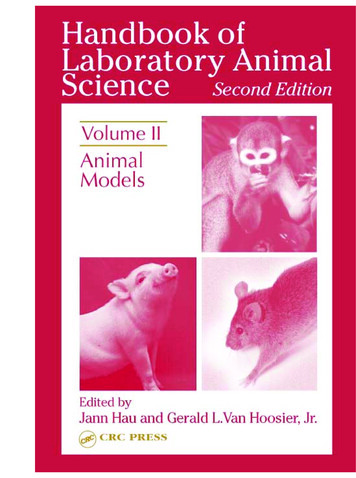
Transcription
Handbook ofLaboratory AnimalScience Second EditionVolume IIAnimalModelsEdited byJann Hau and Gerald L. Van Hoosier, Jr.CRC PR E S SBoca Raton London New York Washington, D.C.
Senior Editor: John SulzyckiProject Editor: Gail RenardProject Coordinator: Pat RobersonCover Designer: Dawn BoydMarketing Manager: Nadja EnglishLibrary of Congress Cataloging-in-Publication DataHandbook of laboratory animal science / edited by Jann Hau, Gerald L. Van Hoosier,Jr.--2nd ed.p. cm.Includes bibliographical references and index.Contents: v. 1. Essential principles and practices.ISBN 0-8493-1086-5 (alk. paper)1. Laboratory animals. 2. Animal experimentation. 3. Animal models in research. I.Hau, Jann. II. Van Hoosier, G. L.QL55 .H36 2002599′ .07′ 24--dc212002031315This book contains information obtained from authentic and highly regarded sources. Reprinted material is quoted withpermission, and sources are indicated. A wide variety of references are listed. Reasonable efforts have been made to publishreliable data and information, but the author and the publisher cannot assume responsibility for the validity of all materialsor for the consequences of their use.Neither this book nor any part may be reproduced or transmitted in any form or by any means, electronic or mechanical,including photocopying, microfilming, and recording, or by any information storage or retrieval system, without priorpermission in writing from the publisher.All rights reserved. Authorization to photocopy items for internal or personal use, or the personal or internal use of specificclients, may be granted by CRC Press LLC, provided that 1.50 per page photocopied is paid directly to Copyright clearanceCenter, 222 Rosewood Drive, Danvers, MA 01923 USA. The fee code for users of the Transactional Reporting Service isISBN 0-8493-1084-9/03/ 0.00 1.50. The fee is subject to change without notice. For organizations that have been granteda photocopy license by the CCC, a separate system of payment has been arranged.The consent of CRC Press LLC does not extend to copying for general distribution, for promotion, for creating new works,or for resale. Specific permission must be obtained in writing from CRC Press LLC for such copying.Direct all inquiries to CRC Press LLC, 2000 N.W. Corporate Blvd., Boca Raton, Florida 33431.Trademark Notice: Product or corporate names may be trademarks or registered trademarks, and are used only foridentification and explanation, without intent to infringe.Visit the CRC Press Web site at www.crcpress.com 2003 by CRC Press LLCNo claim to original U.S. Government worksInternational Standard Book Number (Volume II) 0-8493-1084-9Library of Congress Card Number 2002031315Printed in the United States of America 1 2 3 4 5 6 7 8 9 0Printed on acid-free paper
PrefaceThe Handbook of Laboratory Animal Science, Second Edition: Animal Models, Volume II isdedicated to the use of laboratory animals as models for humans. This book explains in great detailthe comparative considerations underlying the choice of animal species and strains in differentresearch disciplines. Volume II consists of chapters written by experts in their respective fields andcovers a range of scientific areas in which animals play a crucial role as models for humans. Unlikemany other publications, this book is not exclusively restricted to laboratory animal models for thestudy of human diseases. It takes a wider approach, which is in accordance with modern interpretation of the animal model concept.Most of our knowledge of human biology is derived from animal studies, and fortunately, theconservative nature of animal evolution often renders reliable extrapolation of findings betweenspecies the rule rather than the exception. However, we found that there is a great need for ahandbook on the choice of animal species and strains, and on the development and application ofmodels in different areas of biomedical research. The book consequently focuses on the relevantcomparative aspects in the many different contexts in which animals are used as well as on thespontaneous genetic mutants and the genetically modified animal models available within differentresearch areas.The authors have strived to include the most recent information available as well as generallyrecognized facts to make the book relevant, practical, and attractive to other specialists. Reportingfrom the cutting edge of a scientific discipline involves including some, but obviously not all, ofthe most recently reported findings. This selection will invariably make some scientists feel thattheir results have been neglected, and for this we apologize. We welcome comments from readersand colleagues that may assist us in keeping the text up-to-date and in correcting errors.Both Volumes I and II of the Handbook of Laboratory Animal Science are, in many ways,very technical books. We hope that our readers will find them useful, whether they be postgraduatestudents who are not familiar with laboratory animals and their use as research tools, veterinarianswho specialize in laboratory animal science and welfare, or experienced scientists who are lookingfor an overview and reference text of the large and heterogeneous field that is laboratory animalscience.Jann HauUppsala UniversityUppsala, SwedenGerald Van HoosierUniversity of WashingtonSeattle, Washington
About the EditorsJann Hau is Professor of Comparative Medicine at the University of Uppsala in Sweden. Dr. Haugraduated in experimental biology from University of Odense in Denmark after medical and biologystudies in 1977, and specialized in laboratory animal science. Following research fellowships atUniversity of Odense, he did his doctorate (Dr. Med.) at this university. In 1983, he joined theDepartment of Pathology at The Royal Veterinary and Agricultural University (RVAU) in Copenhagen as Associate Professor and Head of the Laboratory Animal Science Unit. He was later Headof the Department of Pathology and Dean of the Faculty of Animal Husbandry and VeterinaryScience at the RVAU.In 1991, he moved to the Royal Veterinary College (RVC) in London as Professor in the LondonUniversity Chair in Laboratory Animal Science and Welfare. At the RVC, he was responsible forthe undergraduate and postgraduate teaching in laboratory animal science and welfare, whichincluded a specialist Master of Science course in Laboratory Animal Science that attracted a numberof postgraduate students from many parts of the world.In 1996, Dr. Hau was appointed Professor in Comparative Medicine in Uppsala and Head ofa new Department of Comparative Medicine. Following amalgamations of departments at themedical faculty, Comparative Medicine is presently integrated with the Department of Physiology,of which Dr. Hau is presently Head. In Uppsala, he has established a number of courses forundergraduate and postgraduate students, including specialist education programs.Dr. Hau has organized several international meetings and courses on laboratory animal science.He is the editor-in-chief of the Scandinavian Journal of Laboratory Animal Science and editor ofthe laboratory animals’ section of the UFAW journal Animal Welfare. He is a member of a numberof laboratory animal science organizations and former president of the Scandinavian Society ofLaboratory Animal Science and the Federation of European Laboratory Animal Science Associations.Dr. Hau has supervised many postgraduate Master’s and Ph.D. students and published severalhundred scientific papers and chapters in books. Together with Dr. P. Svendsen, he wrote the firstDanish textbook on laboratory animals and animal experiments published in 1981, 1985, and 1989,and they co-edited the first edition of the CRC Handbook of Laboratory Animal Science, publishedin 1994.Dr. Hau’s current research interests include development of refined laboratory animal modelsfor studies of biological mechanisms in reproductive biology and infections as well as developmentof methods to assess stress and welfare in animals. His research activities also include projectsfocused on ways to replace, reduce, and refine the use of animals in antibody production.Gerald L. Van Hoosier, Jr., is Professor of Comparative Medicine in the School of Medicine atthe University of Washington in Seattle, Washington. Dr. Van Hoosier graduated from the Collegeof Veterinary Medicine at Texas A&M University at College Station, Texas, in 1957 and subsequently obtained postdoctoral training in virology and epidemiology at Berkeley, California, andin pathology at Baylor College of Medicine in Houston, Texas. From 1957 to 1962, he served asa Commissioned Officer in the U.S. Public Health Service assigned to the biologics program atthe National Institutes of Health in Bethesda, Maryland, where he focused on the development andsafety evaluation of poliomyelitis and measles vaccines. Following 5 years in the Public HealthService, Dr. Van Hoosier joined the faculty of the Division of Experimental Biology at BaylorCollege of Medicine in Houston, Texas, and did research on the role of viruses in the etiology ofcancer. In 1969, he moved to Pullman, Washington, where he was a faculty member in theDepartment of Veterinary Pathology in the School of Veterinary Medicine and Director of Laboratory Animal Resources at Washington State University. He introduced a course on laboratoryanimals into the third year of the veterinary school curriculum, taught a graduate course on thepathology of laboratory animals, and began the development of a series of audio tutorials in
collaboration with the American College of Laboratory Animal Medicine. In 1975, Dr. Van Hoosierwas invited to develop an experimental animal program at the University of Washington. Heobtained a training grant for veterinarians from the National Institutes of Health and establishedthe Department of Comparative Medicine, which offers a Master’s degree. He served as thedepartment chairman and Attending Veterinarian until 1995.After becoming a Diplomate of the American College of Laboratory Animal Medicine in 1968,he served as President in 1977–1978. Other professional activities have included serving as Chairman of the Board of Trustees of the American Association for Accreditation of Laboratory AnimalCare in 1981–1982, President of the American Association of Laboratory Animal Science in 1992,and a member of the Governing Board of the International Council for Laboratory Animal Sciencefrom 1995 to 1999. In addition to approximately 100 scientific papers, Dr. Van Hoosier was a coeditor of Laboratory Hamsters, one of a series of texts by the American College of LaboratoryAnimal Medicine and served as editor of Laboratory Animal Science from 1995 to 1999. He iscurrently a member of the Editorial Council of the Baltic Journal of Laboratory Animal Scienceand Animales de Experimentacion.He is the recipient of the Griffin Award from the American Association of Laboratory AnimalScience and a Distinguished Alumni Award from the College of Veterinary Medicine at Texas A&MUniversity.
ContributorsAbbas ArdehaliDivision of Cardiothoracic SurgeryUCLA Medical CenterSchool of MedicineLos Angeles, CaliforniaJörgen JönssonInstitute of OdontologyHuddinge University HospitalKarolinska InstituteStockholm, SwedenKarsten BuschardBartholin InstituteCopenhagen, DenmarkBjörn KlingeInstitute of OdontologyHuddinge University HospitalKarolinska InstituteStockholm, SwedenAnthony M. CarterDepartment of Physiology andPharmacologyUniversity of Southern DenmarkOdense, DenmarkOtto MeyerDanish Veterinary and Food AdministrationSoborg, DenmarkChristi M. CavaliereSection of Plastic SurgeryUniversity of MichiganAnn Arbor, MichiganJesper MogensenCognitive NeuroscienceDepartment of PsychologyUniversity of CopenhagenCopenhagen, DenmarkRyan P. FrankDepartment of Orthopedic SurgeryUniversity of MichiganAnn Arbor, MichiganCynthia E. GloverDepartment of Comparative MedicineUniversity of WashingtonSeattle, WashingtonKurt D. HankensonDepartments of Orthopedic Surgery and the Unitfor Laboratory Animal MedicineUniversity of MichiganAnn Arbor, MichiganJann HauUniversity of UppsalaUppsala, SwedenRobert MurisonDepartment of Biological and MedicalPsychologyUniversity of BergenBergen, NorwayJørgen RygaardBartholin InstituteCopenhagen, DenmarkOve SvendsenDepartment of Pharmacology andPathobiologyRoyal Veterinary and Agricultural UniversityFrederiksberg, DenmarkRikke ThonTaconic M & BLille Skensved, DenmarkHenrik Elvang JensenLaboratory of Veterinary PathologyRoyal Veterinary and Agricultural UniversityFrederiksberg, DenmarkGerald L. Van Hoosier, Jr.University of WashingtonSeattle, WashingtonDavid WhitingDivision of Cardiothoracic SurgeryUCLA Medical CenterSchool of MedicineLos Angeles, California
Table of ContentsChapter 1Animal Models.1Jann HauChapter 2Animal Models in Pharmacology and Toxicology.11Otto Meyer and Ove SvendsenChapter 3Animal Models in Fetal Growth and Development .41Anthony M. CarterChapter 4Animal Models of Nephrological Disorders .55Cynthia E. GloverChapter 5Animal Models for Xenotransplantation .81David Whiting and Abbas ArdehaliChapter 6Animal Models in Neuroscience .95Jesper MogensenChapter 7Animal Models for Psychological Disorders .111Robert MurisonChapter 8Animal Models in Mycology.125Henrik Elvang JensenChapter 9Diabetic Animal Models .153Karsten Buschard and Rikke ThonChapter 10Animal Models of Skeletal Disease .183Kurt D. Hankenson, Christi M. Cavaliere, and Ryan P. FrankChapter 11Animal Models in Cancer Research.225Jørgen RygaardChapter 12Animal Models in Oral Health Sciences.237Björn Klinge and Jörgen JönssonIndex .263
CHAPTER1Animal ModelsJann HauCONTENTSIntroduction .1The Concept of Animal Models .2Classification of Animal Models .2Classification of Disease Models.3Induced (Experimental) Disease Models .3Spontaneous Animal Disease Models.4Transgenic Disease Models.4Negative Animal Models.5Orphan Animal Models .5Extrapolation from Animals to Humans.5Model Body Size and Scaling .6Conclusion.7References .8INTRODUCTIONMost of our basic knowledge of human biochemistry, physiology, endocrinology, and pharmacology has been derived from initial studies of mechanisms in animal models.1 Throughout history,scientists have performed experiments on animals with the aim of obtaining knowledge of animaland human biological structure and function (see, e.g., Held;2 Loew3). Often such studies have notbeen and are not possible in the human. This may be due to ethical or religious considerations, butoften practical, economic, and scientific reasons make initial studies in animals the best solutionto studies of a biological phenomenon.Laboratory animal science may be defined as the study of the scientific, ethical, and legal useof animals in biomedical research, that is, a multidisciplinary field encompassing biological andpathobiological specialties for the optimal scientific use of animals as models for humans or otherspecies.Basic laboratory animal science is concerned with the quality of animals as sentient tools inbiomedical research. It encompasses comparative biology of laboratory animals, technical aspectsof breeding, housing and husbandry, anesthesia, euthanasia, and experimental techniques. Laboratory0-8493-1084-9/03/ 0.00 1.50 2003 by CRC Press LLC1
2HANDBOOK OF LABORATORY ANIMAL SCIENCE, SECOND EDITIONanimal medicine is a veterinary specialty, focusing on the diagnosis, treatment, and prevention ofdiseases in animals used as subjects in biomedical activities. High-quality animals and animal careensure the highest possible health and welfare status of the animals and are prerequisites for goodscience and public acceptance of the use of animals in research.Volume I of this handbook is an introduction to basic laboratory animal science, whereas thepresent volume focuses on applied laboratory animal science, which is the use of animals as modelsfor humans — or in some instances as models for other species.THE CONCEPT OF ANIMAL MODELSA model is an object of imitation, something that accurately resembles something else, a personor thing that is the likeness or image of another.4 Prometheus, who has been deigned by poets tohave first formed Man, formed a model from water and earth and then stole fire from the sun toanimate the model.5 An animal model is thus an animated object of imitation in the image ofhumans (or other species), used to investigate biological or pathobiological phenomena.A laboratory animal model describes a biological phenomenon that the species has in commonwith the target species.6 A more accurate definition has been given by Held on the basis of Wessler’soriginal definition:7 “a living organism in which normative biology or behavior can be studied, orin which a spontaneous or induced pathological process can be investigated, and in which thephenomenon in one or more respects resembles the same phenomenon in humans or other speciesof animal.” What is generally understood by the term “animal model” is modeling of humans. Itis not the image of the used animal that is the focus of research but the analogy of the physiologicalbehavior of this animal to our own (or another) species. It would thus be more correct to refer toanimals as “human models” in this context. Laboratory animal science, comparative medicine, andanimal experiments are indeed much more about humans than about any other animal species.8The significance and validity with respect to usefulness in terms of “extrapolatability” of resultsgenerated in an animal model depend on the selection of a suitable animal model. A good knowledgeof comparative anatomy and physiology is an obvious advantage when developing an animal model.Animal models may be found throughout the animal kingdom, and knowledge about humanphysiology has been achieved in species far removed from the human in terms of evolutionarydevelopment. A good example is the importance of the fruit fly for the original studies of basicgenetics. Animal models are used in virtually every field of biomedical research, as reflected in thechapters of this book.CLASSIFICATION OF ANIMAL MODELSA plethora of animal models has been used and is being used and developed for studies ofbiological structure and function in the human. The models may be exploratory, aiming to understand a biological mechanism, whether this is a mechanism operative in fundamental normal biologyor a mechanism associated with an abnormal biological function. Models may also be developedand applied as so-called explanatory models, aiming to understand a more or less complex biologicalproblem. Explanatory models need not necessarily be reliant on the use animals but may also bephysical or mathematical model systems developed to unravel complex mechanisms. A thirdimportant group of animal models is employed as predictive models. These models are used withthe aim of discovering and quantifying the impact of a treatment, whether this is to cure a diseaseor to assess toxicity of a chemical compound. The anatomy or morphology of the model structureof relevance to the studies may be of importance in all three of these model systems. The extentof resemblance of the biological structure in the animal with the corresponding structure in humans
ANIMAL MODELS3has been termed fidelity. A high-fidelity model with close resemblance to the human case may seeman obvious advantage when developing certain models. What is often more important, however, isthe discriminating ability of the models, in particular the predictive models. When using models,for instance to assess the carcinogenicity of a substance, it is of the essence that at least one of themodel species chosen responds in a manner that is predictive of the human response to thissubstance. Thus the similarity between humans and model species with respect to relevant biologicalmechanism is often more important than the fidelity of the model. Often the two go hand in hand,and high-fidelity models offer the best opportunity to study a particular biological function.An animal model may be considered homologous if the symptoms shown by the animal andthe course of the condition are identical to those of humans.9 Models fulfilling these requirementsare relatively few, but an example is well-defined lesion syndromes in, for instance, neuroscience.10An animal model is considered isomorphic if the animal symptoms are similar but the cause of thesymptoms differs between human and model. However, most models are neither homologous norisomorphic but may rather be termed “partial.” These models do not mimic the entire human diseasebut may be used to study certain aspects or treatments of the human disease.10CLASSIFICATION OF DISEASE MODELSThe majority of laboratory animal models are developed and used to study the cause, nature,and cure of human disorders. They may conveniently be categorized in one of the following fivegroups, of which the three first are the most important, as given in numerical order:1.2.3.4.5.Induced (experimental) disease modelsSpontaneous (genetic) disease modelsTransgenic disease modelsNegative disease modelsOrphan disease modelsInduced (Experimental) Disease ModelsAs the name implies, induced models are healthy animals in which the condition to be investigated is experimentally induced, for instance, the induction of diabetes mellitus with encephalomyocarditis virus,11 allergy against cow’s milk through immunization with minute doses ofprotein,12 or partial hepatectomy to study liver regeneration.13 The induced-model group is the onlycategory that theoretically allows a free choice of species. Although one might be tempted topresume that extrapolation from an animal species to the human is the better the closer this speciesresembles humans (high fidelity), phylogenetic closeness, as fulfilled by primate models, is not aguarantee for validity of extrapolation, as the unsuccessful chimpanzee models in acquired immunodeficiency syndrome (AIDS) research have demonstrated.14 It is just as decisive that the pathologyand outcome of an induced disease or disorder in the model species resembles the respective lesionsof the target species. Feline immunodeficiency virus infection in cats may therefore for many studiesbe a better model for human AIDS than is human immunodeficiency virus infection in simians.Although mice and rats have many biological characteristics in common, they do not necessarilyserve equally well as models of human disease. For example, schistosomiasis (mansoni ) infectionmay be studied in experimentally infected mice but not in rats, whose immune system is able tofight the infection effectively.15Most induced models are partial or isomorphic because the etiology of a disease experimentally induced in an animal is often different from that of the corresponding disease in the human.Few induced models completely mimic the etiology, course, and pathology of the target diseasein the human.
4HANDBOOK OF LABORATORY ANIMAL SCIENCE, SECOND EDITIONSpontaneous Animal Disease ModelsThese models of human disease use naturally occurring genetic variants (mutants). Manyhundreds of strains and stocks with inherited disorders modeling similar conditions in humans havebeen characterized and conserved (see, e.g., http://www.jax.org). A famous example of a spontaneous mutant model is the nude mouse,16 which was a turning point in the study of heterotransplanted tumors and, for instance, enabled the first description of natural killer cells. Other famousspontaneous models include Snell’s dwarf mice, without a functional pituitary,17 and the curly-tailmouse, in which fetuses develop a whole range of neural-tube defects.18 Many of the mutants areavailable in inbred strains, with corresponding coisogenic or congenic strains. This is very usefulbecause the influence of just one affected gene or locus may then be studied against a referencestrain with similar genetic background as the mutant (see also Volume I, Chapter 9).An extensive literature is available on spontaneous models, and the majority of these are miceand rat models, although a wide range of mutants in many different species has been described. Agood example of the amount of information available is the publication of Migaki,19 which references 200 diseases in animals exclusively caused by inborn errors of metabolism.The spontaneous models are often isomorphic, displaying phenotypic similarity between thedisease in the animal and the corresponding disease in the human — this is called face validity;for instance, type I diabetes in humans and insulin-requiring diabetes in the BB rat. This phenotypicsimilarity often extends to similar reactions to treatment in the model animal and the human patient,and spontaneous models have been important in the development of treatment regimens for humandiseases.However, if the object of a project is to study the genetic causes and etiology of a particulardisease, then comparable genomic segments involved in the etiology of the disorder — constructvalidity — is normally a requirement. It should be remembered, however, that an impaired geneor sequence of genes very often results in activation of other genes and mobilization of compensatingmetabolic processes. These compensatory mechanisms may of course differ between humans andthe animal model species.Transgenic Disease ModelsThe rapid developments in genetic engineering and embryo manipulation technology duringthe past decade have made transgenic disease models perhaps the most important category of animaldisease models. A multitude of animal models for important diseases have been developed sincethis technology became available, and the number of models seems to be increasing quickly. Miceare by far the most important animals for transgenic research purposes, but farm animals and fishare also receiving considerable interest.Many physiological functions are polygenic and controlled by more than one gene, and it willrequire considerable research activities to identify the contribution of multiple genes to normal aswell as abnormal biological mechanisms. The insertion of DNA into the genome of animals or thedeletion of specific genes gives rise to sometimes unpredictable outcomes in terms of scientificresults as well as in terms of animal well-being in the first generations of animals produced.Thereafter, transgenic lines can be selected and bred or cloned to avoid or select for a specificgenotype. It is not an accurate science, although the methodology is constantly improving with theaim of eliminating unwanted effects. The embryo manipulation procedures themselves do not appearto affect the welfare of offspring in the mouse,20 and the large-offspring syndrome observed in farmanimals has so far not been reported in rodents (see Volume I, Chapter 18 for welfare aspectsassociated with transgenic animals).Mutations induced by the use of mutagens such as ethyl-nitroso-urea represent another approachto the generation of new mutants, which may serve as models of human disorders. In many aspects,these mutants may be similar to spontaneous mutants and to the ones generated by transgenic
ANIMAL MODELS5embryo manipulation. The maintenance of a line raises similar issues for chemically induced geneticmutants as for animals that have been genetically modified through embryo manipu
Handbook of Laboratory Animal Science, Second Edition: Animal Models, Volume II is dedicated to the use of laboratory animals as models for humans. This book explains in great detail the comparative considerations underlying the choice of animal species and strains in different research disciplines.
